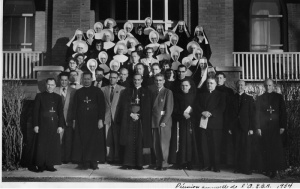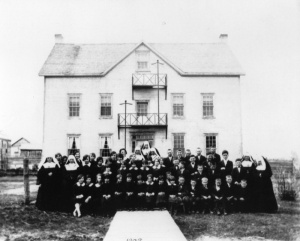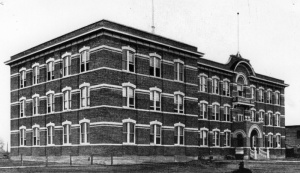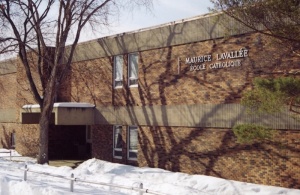French-language Education in Alberta
par Levasseur-Ouimet, France and McMahon, François
Access to French education has been central to the development of French life in Alberta. The history of the Franco-Albertan community’s struggle for French-language education has profoundly marked the community’s identity and constitutes a fundamental and original part of its heritage. Without the courage and tenacity of past generations, today’s Franco-Albertans would not have the opportunity to educate their children in French. The political battles of the past allow over 5,000 students to attend Alberta French schools today.
Article disponible en français : Éducation française en Alberta
A Vital Heritage
From the moment compulsory
schooling was introduced in Alberta,
access to French Catholic schools became a major issue for francophone
communities. Community members were convinced that schooling was key to
ensuring the survival of their culture and helping their children succeed in
society.
The first French schools were established in the 1860s, but were banned some
thirty years later by regional authorities, not long after Alberta’s anglophone population achieved
majority status. After a century of hard-fought battles, French-language public
schools were finally re-established in the 1980s. Since then, the francophone
school system has grown steadily. Faithful to its origins, it transmits the
language and culture of the community’s forebears while at the same time
adapting to the extraordinary changes required by globalization, new technology
and the arrival of numerous francophone immigrants of non-European origin. As
such, French-language public schools play a pivotal role in the transmission of
Franco-Albertan culture and heritage.
In many ways, the history of French-language education in Alberta also mirrors the experiences and aspirations of the Franco-Albertan community. French-language instruction is without doubt one of the community’s most important legacies.
The First Schools
In 1859, the Grey Nuns opened a school at Lac Ste. Anne, in what would eventually become Alberta. Three years later, they opened a second facility at the Lac La Biche mission. In 1862, Father Lacombe did the same in Fort Edmonton. These early schools marked the beginnings of French Catholic education in Alberta.
In 1870, the Canadian government passed the Rupert’s Land Act after purchasing what became known as the North-West Territories, a vast expanse encompassing most of the present-day Prairie Provinces and much of the Canadian North. Neither this Act nor the subsequent North-West Territories Act of 1875 made any provisions for a bilingual population. However, Section 11 of the latter did give minority ratepayers in each school district—be they Catholic or Protestant—the right to establish and maintain separate schools. Since most Catholics at the time were also francophone, the act helped foster French education by allowing for the creation of school districts and separate schools where French was the language of instruction.
Things changed in 1892, when Ordinance No. 22, Section 83, established English as the official language of instruction in the Territories. This was modified in 1896 and again in 1901 to permit the teaching of a French primary course for students who did not understand English. More specifically, the 1901 amendment stipulated that school boards could authorize the use of French during a year of primary school and gave them the necessary authority to raise the money required for teachers’ salaries by levying a special tax on parents who wanted such teaching.
Further to lobbying by Franco-Albertan community, a more clearly defined and practical interpretation of Section 184 of the School Ordinance dealing with the teaching of the French primary course came into effect on September 1, 1925. From this point on, French became an authorized subject for francophone children in all schools where school boards decided by resolution to offer a French primary course. During the first year of schooling, French could also be used to teach other subjects. However, spoken English was taught from first grade, and English reading was introduced in second grade as soon as children had learned to read in their mother tongue. And from third to eighth grade (grade nine as of 1945) a maximum of one hour per day could be devoted to French. This included grammar, reading, analysis, dictation and composition.
There were several exceptions to the principle of English-language instruction, including the obligation to use explanations in French when students did not understand. A network of private French-language schools was also established, including Juniorat Saint-Jean (1908), Collège des Jésuites (1913) and Académie Assomption (1926).
Francophone Associations Join the Fight
During this period, the political fight for French schooling was spearheaded primarily by Association canadienne-française de l'Alberta (ACFA). Educational support was provided by Association des instituteurs bilingues de l'Alberta (AIBA), founded in 1926, then by Association des éducateurs bilingues de l'Alberta (AEBA) as of 1946. Prior to 1965, Alberta’s Ministry of Education provided no pedagogical support for the teaching of French and religion, so it was the AIBA and the AEBA that oversaw curriculum development, evaluations, teacher training and the development of cultural activities. All of this work was carried out by volunteers. Many Franco-Albertans remember the famous AEBA French exam that all francophone students in grades three through twelve had to write every year. The list of results was published in the newspaper La Survivance.
In 1963, the AEBA board of directors examined the possibility of setting up a council of experts made up of bilingual teachers under the auspices of the Alberta Teachers’ Association (ATA). So came into being ATA’s Conseil français, which eventually replaced the AEBA. For the first time, the ATA recognized the existence of the province’s francophone teachers.
School districts wishing to offer French primary courses had to adopt an annual resolution to that effect, so it was important to ensure that francophone school trustees were aware of the importance of French-language education in their respective regions. In 1935, Association des commissaires d’écoles de langue française de l’Alberta (ACBA) was established with this goal in mind. By 1941, this association of francophone school trustees numbered 200 members and represented 95 schools where French was taught for one hour a day.
In April 1968, the Government of Alberta passed legislation to permit French-language instruction for up to half the school day. In 1976, Regulation 250/76 extended this provision to allow the use of French for up to 80% of the school day. For all intents and purposes, francophones could now be educated in their own language. But the government made no distinction between francophone and anglophone students, who were grouped together in bilingual schools. Between 1968 and 1982, a growing number of young anglophones opted for French-language schooling at Alberta’s bilingual schools, which essentially became immersion schools.
The Impact of the Charter of Rights
Unfortunately, immersion schools served as a vector for francophone assimilation, a problem that was addressed in 1982 in Section 23 of the Canadian Charter of Rights and Freedoms. Section 23 guaranteed three complementary and interdependent rights: the right to minority language education, the right to minority language educational institutions and the right to manage those institutions.
However, the Charter provisions on French schools sparked major battles in the face of resistance from government and school officials. Francophone minority communities across Canada were forced to contest government inaction in court. In 1983, the Bugnet group decided to take the Alberta government to court; the Mahé/Bugnet case ultimately went all the way to the Supreme Court of Canada in 1990.
The struggle for French schools took a great deal of courage and tenacity, but the outcome was positive. In 1983, École Georges and Julia Bugnet, a private, non-denominational French elementary school, opened its doors in Edmonton. In May of that same year, a group of parents formed an ad hoc committee to establish a publicly funded French Catholic high school. Edmonton’s École Maurice-Lavalléé and Calgary’s École Saint-Antoine opened in 1984. Numerous other schools would soon join them.
In 1988, six years after the Canadian Charter of Rights and Freedoms came into force, Alberta tabled new school legislation recognizing the right to separate French schools, but ignoring the right to management. That same year, the government issued a ministerial policy on language education in Alberta that left the matter to the discretion of local school boards.
In 1989, École Maurice Lavallée welcomed its first complete contingent of students from kindergarten through to grade 12. The victory came at the cost of colossal effort and years of work by the leaders of Société des parents pour l’école française de Edmonton. The group even occupied the office of the Edmonton Separate School Board in March 1988. Two years later, in March 1990, the right to management was finally confirmed by the Supreme Court in its ruling in the Mahé/Bugnet case.
Francophones Gain Full Management
On January 11, 1991, Alberta’s minister of Education, Jim Dinning, established the French Language Working Group, which was tasked with drawing up recommendations regarding French-language education and the governance of francophone schools in Alberta. The Group submitted a unanimous report in May of 1991 recommending the creation of francophone school boards and coordinating councils. In 1993, the Alberta government amended the Alberta School Act. Francophones finally obtained management control over their own schools. For a number of years, Alberta had the best francophone school system outside Quebec and New Brunswick.
In March 1994, the Franco-Albertan community elected francophone school trustees in a number of regions across the province, a historic moment in the 101-year-long struggle for French-language education in Alberta.
By September 2007, there were five francophone school boards in Alberta totalling more than 5,000 students, an almost 50% increase over the previous five years at a time when other school boards were seeing declining enrolments. These schools have become incubators for future leaders in every field of endeavour, including the arts, politics, sports, recreation and social activism. The Franco-Albertan community has been infused with new energy and vitality. Its forebears were right to invest so much time and effort in schools, the cornerstone of the community today.
François McMahon
France Levasseur-Ouimet
Campus Saint Jean, University of Alberta
Additional DocumentsSome documents require an additional plugin to be consulted
Images
-
 L'école Grandin ‑ éco
L'école Grandin ‑ éco
le bilingue -
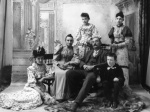 M. Georges Roy et sa
M. Georges Roy et sa
famille -
 Pavillon Lacerte – Sa
Pavillon Lacerte – Sa
int-Jean -
 Père Arthur Lacerte
Père Arthur Lacerte

